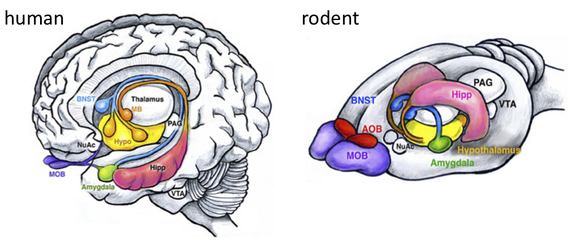For decades, psychologists, neuroscientists and brain mappers have studied fear and anxiety using language that obscures the distinctions between these complex emotional states. The difficulty in articulating the unique characteristics of these complex emotions has prevented a differentiation in not only their semantic definitions, but also their neurobiological underpinnings. In parallel, many of the therapeutic approaches to anxiety or fear related disorders [e.g., obsessive compulsive disorder (OCD) or post-traumatic stress disorder (PTSD)] are more universal (e.g., exposure therapy) than perhaps would be most optimal if unique brain mechanisms were known to underlie fear and anxiety. Despite the lack of conclusive evidence, intuitively, you can imagine fear as a fast automatic response to a threat and anxiety as a seemingly endless sense of dread about an imminent or future threat. While past neuroimaging work in humans has generated lots of ideas regarding the underlying neural mechanisms that distinguish fear from anxiety, none have yet been conclusively proven. Work in rodents suggests that the main differentiation lies in the distinct roles of two brain regions, the amygdala and the bed nucleus of the stria-terminalis (BNST), when the animal is experiencing only fear or only anxiety. Based on these findings, the question then becomes: Is it possible that the complexity of human emotion is similarly differentiated between these two structures as it is in rodents?

The amygdala and the bed nucleus of the stria terminalis (BNST) in humans and rodents. A schematic illustration of the human (left) and rodent (right) brain showing the amygdala (green) and BNST (blue), as well as other structures involved in emotion processing. Image adapted from Sokolowski and Corbin, 2012.
The answer seems to be yes. In a recent neuroimaging study, Herrmann and colleagues used fMRI to examine neural responses of the amygdala and BNST to detect differences in responses to the sound of human screams and neutral tones that a participant heard while laying in the scanner. The authors varied the length of time between a cue indicating that a negative (a scream) or neutral event would occur and when the sound occurred to manipulate the duration of the anticipatory period prior to each auditory stimulus.
After analyzing participants' brain data, the authors concluded that the amygdala responds in a relatively quick manner to the cues, however activation decreases fairly rapidly. In contrast, while the BNST also responded rapidly to the onset of the cue, that brain region remained active for the duration of the time between the cue and stimuli.
These results suggest that, similar to what was found in the rodent model, different neural mechanisms that include differential involvement of these two brain structures generate fear and anxiety responses. And of course, as we have stressed in prior posts, entire networks in the brain are necessary for the complexity of our emotions and thoughts. Nevertheless, the findings from this study illustrate the benefit of designing an experiment geared to potentially dissociate the functionality of one region from another. Further understanding of these neural regions and their responses will hopefully lead to greater adoption of the specific therapeutic approaches that have been developed for each of the psychiatric disorders involving fear and anxiety (for more information see Beck, Emery and Greenberg 2005).
Brendan Depue is a neuroscientist, as well as member of the Organization for Human Brain Mapping (OHBM) and writes for the Communications/Media Team. The OHBM Media Team brings cutting edge information and research on the human brain to your laptops, desktops and mobile devices in a way that is neurobiologically pleasing. For more information about brain mapping, follow www.humanbrainmapping.org/blog or @OHBMSci_News
Further reading: